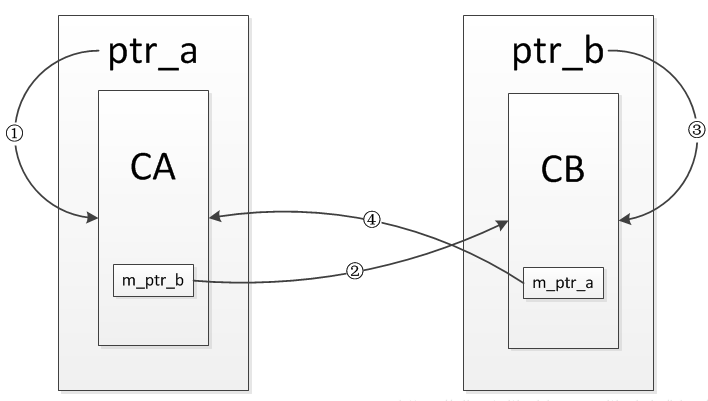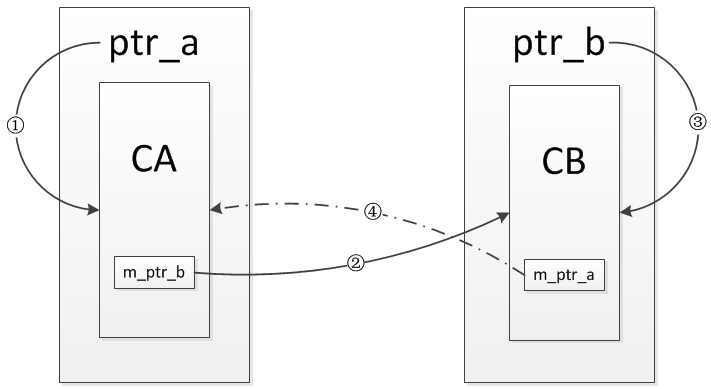Lambda表达式和智能指针
Lambda表达式
-
匿名函数
-
Capture list (外部变量访问方式说明符)
-
可以是=或&,表示{}中用到的、定义在{}外面的变量在{}中是否允许被改变
-
=表示只读,&表示可修改。在[]为空时,不使用定义在外面的变量
-
->可以省略,让编译器自行推导
[capture list] (parameter list) -> return type declaration { lambda body } -
[]表示外部变量不可见
-
[=, &x, &y]表示外部变量x、y的值可以被修改,其余外部变量不能被修改,但是可见
-
[&, x, y]表示除x、y以外的外部变量,值都可以被修改
#include <iostream> #include <vector> int main() { size_t a = 5; std::vector<size_t> v = {1, 2, 3, 4, 5, 6, 7, 8, 9, 10}; auto b = [&a, v](std::vector<size_t> vc) -> void { while (a != 0) { std::cout << vc[a] << " "; --a; } }; b(v); return 0; } //输出结果:6 5 4 3 2 -
智能指针unique_ptr、shared_ptr和weak_ptr
帮助我们管理内存,避免内存泄露。因为new和delete并不是有机整合在一起的操作,所以易造成内存泄露。
智能指针管理内存的方法原理时像类的构造函数和析构函数一样,内存分配和回收有机整合,使用构造函数和析构函数包含指针,在不需要时自动将指针析构。其中unique_ptr对应构造函数的move语义(move构造函数),而share_ptr对应构造函数的copy语义(拷贝构造函数)。
-
unique_ptr
在类unique_ptr中,可以看到 unique_ptr(const unique_ptr&) = delete; unique_ptr& operator=(const unique_ptr&) = delete; unique_ptr类的拷贝构造方法和复制构造方法被禁用。unique_ptr的独一性就是靠将其拷贝构造函数和复制构造函数禁用来实现的。
#include <iostream>
#include <memory>
using namespace std;
class A {
public:
void foo() {
cout << "foo() called." << endl;
}
};
int main(){
//A* nakePtr = new A; 这样不利于内存管理,需要手动释放nakePtr
unique_ptr<A> r1 {make_unique<A>()}; //声明一个unique_ptr的智能指针指向一个A对象
auto r2 {make_unique<A>()}; //同上
//unique_ptr具有独一性,有一个指针指向该对象,不能同时有别的指针指向该对象,
//auto r3 = r1; unique_ptr类中拷贝构造函数被禁用,故该操作是非法的
//auto r3(r1); unique_ptr类中复制构造函数被禁用,故该操作非法
auto r3 = move(r1); //合法,因为unique_ptr的move构造函数并未被禁用
r3->foo();
return 0;
}
gdb调试如下:
在执行auto r3 = move(r1)之前

在执行auto r3 = move(r1)之后

-
shared_ptr
share_ptr允许有多个指针指向同一对象,同时会有一个use count,来表示有多少个指针同时指向该对象,当该对象的use count为0时,该对象会被自动析构。
#include <iostream>
#include <memory>
using namespace std;
class A {
public:
int a;
A(int _a = 0) : a(_a){};
~A() { cout << a << ":destructor called.\n"; }
};
int main() {
//A* nakePtr = new A; 这样不利于内存管理,需要手动释放nakePtr
shared_ptr<A> r1{make_shared<A>(1)}; //声明一个shared_ptr的智能指针指向一个A对象
shared_ptr<A> r2 = r1; //unique_ptr类中拷贝构造函数被禁用,故该操作是非法的
r1.reset(new A(2)); //将r1重新指向一个新的A对象
r2.reset(new A(3)); //将r2重新指向一个新的A对象
return 0;
}
执行结果:
1:destructor called.
3:destructor called.
2:destructor called.
r1和r2被重设为指向新的对象后,值为1的对象的use count变为0,随即被析构掉,然后函数返回,按栈上顺序依次析构值为3和值为2的对象。
在执行shared_ptr<A> r2 = r1 之前

在执行shared_ptr<A> r2 = r1之后

执行r1.reset(new A(2));后,use count减1,变为1

再次执行r2.reset(new A(3));后,use count减1,变为0,析构值为1的对象。
-
weak_ptr
前言
weak_ptr这个指针天生一副“小弟”的模样,也是在C++11的时候引入的标准库,它的出现完全是为了弥补它老大shared_ptr天生有缺陷的问题,其实相比于上一代的智能指针auto_ptr来说,新进老大shared_ptr可以说近乎完美,但是通过引用计数实现的它,虽然解决了指针独占的问题,但也引来了引用成环的问题,这种问题靠它自己是没办法解决的,所以在C++11的时候将shared_ptr和weak_ptr一起引入了标准库,用来解决循环引用的问题。
weak_ptr本身也是一个模板类,但是不能直接用它来定义一个智能指针的对象,只能配合shared_ptr来使用,可以将shared_ptr的对象赋值给weak_ptr,并且这样并不会改变引用计数的值。查看weak_ptr的代码时发现,它主要有lock、swap、reset、expired、operator=、use_count几个函数,与shared_ptr相比多了lock、expired函数,但是却少了get函数,甚至连operator* 和 operator->都没有,可用的函数数量少的可怜,下面通过一些例子来了解一下weak_ptr的具体用法。
使用环境
VS2015 + Windows7(应该是C++11标准)
头文件#include <memory>
命名空间using namespace std;
测试过程
1.weak_ptr解决shared_ptr循环引用的问题
定义两个类,每个类中又包含一个指向对方类型的智能指针作为成员变量,然后创建对象,设置完成后查看引用计数后退出,看一下测试结果:
class CB;
class CA{
public:
CA() { cout << "CA() called! " << endl; }
~CA() { cout << "~CA() called! " << endl; }
void set_ptr(shared_ptr<CB>& ptr) { m_ptr_b = ptr; }
void b_use_count() { cout << "b use count : " << m_ptr_b.use_count() << endl; }
void show() { cout << "this is class CA!" << endl; }
private:
shared_ptr<CB> m_ptr_b;
};
class CB{
public:
CB() { cout << "CB() called! " << endl; }
~CB() { cout << "~CB() called! " << endl; }
void set_ptr(shared_ptr<CA>& ptr) { m_ptr_a = ptr; }
void a_use_count() { cout << "a use count : " << m_ptr_a.use_count() << endl; }
void show() { cout << "this is class CB!" << endl; }
private:
shared_ptr<CA> m_ptr_a;
};
void test_refer_to_each_other(){
shared_ptr<CA> ptr_a(new CA());
shared_ptr<CB> ptr_b(new CB());
cout << "a use count : " << ptr_a.use_count() << endl;
cout << "b use count : " << ptr_b.use_count() << endl;
ptr_a->set_ptr(ptr_b);
ptr_b->set_ptr(ptr_a);
cout << "a use count : " << ptr_a.use_count() << endl;
cout << "b use count : " << ptr_b.use_count() << endl;
}
测试结果如下:
CA() called!
CB() called!
a use count : 1
b use count : 1
a use count : 2
b use count : 2
通过结果可以看到,最后CA和CB的对象并没有被析构,其中的引用效果如下图所示,起初定义完ptr_a和ptr_b时,只有①③两条引用,然后调用函数set_ptr后又增加了②④两条引用,当test_refer_to_each_other这个函数返回时,对象ptr_a和ptr_b被销毁,也就是①③两条引用会被断开,但是②④两条引用依然存在,每一个的引用计数都不为0,结果就导致其指向的内部对象无法析构,造成内存泄漏。

解决这种状况的办法就是将两个类中的一个成员变量改为weak_ptr对象,因为weak_ptr不会增加引用计数,使得引用形不成环,最后就可以正常的释放内部的对象,不会造成内存泄漏,比如将CB中的成员变量改为weak_ptr对象,代码如下:
class CB{
public:
CB() { cout << "CB() called! " << endl; }
~CB() { cout << "~CB() called! " << endl; }
void set_ptr(shared_ptr<CA>& ptr) { m_ptr_a = ptr; }
void a_use_count() { cout << "a use count : " << m_ptr_a.use_count() << endl; }
void show() { cout << "this is class CB!" << endl; }
private:
weak_ptr<CA> m_ptr_a;
};
测试结果如下:
CA() called!
CB() called!
a use count : 1
b use count : 1
a use count : 1
b use count : 2
~CA() called!
~CB() called!
通过这次结果可以看到,CA和CB的对象都被正常的析构了,引用关系如下图所示,流程与上一例子相似,但是不同的是④这条引用是通过weak_ptr建立的,并不会增加引用计数,也就是说CA的对象只有一个引用计数,而CB的对象只有2个引用计数,当test_refer_to_each_other这个函数返回时,对象ptr_a和ptr_b被销毁,也就是①③两条引用会被断开,此时CA对象的引用计数会减为0,对象被销毁,其内部的m_ptr_b成员变量也会被析构,导致CB对象的引用计数会减为0,对象被销毁,进而解决了引用成环的问题。

2.测试weak_ptr对引用计数的影响
其实weak_ptr本身设计的很简单,就是为了辅助shared_ptr的,它本身不能直接定义指向原始指针的对象,只能指向shared_ptr对象,同时也不能将weak_ptr对象直接赋值给shared_ptr类型的变量,最重要的一点是赋值给它不会增加引用计数:
void test1(){
// 编译错误 // error C2665: “std::weak_ptr<CA>::weak_ptr”: 3 个重载中没有一个可以转换所有参数类型
// weak_ptr<CA> ptr_1(new CA());
shared_ptr<CA> ptr_1(new CA());
cout << "ptr_1 use count : " << ptr_1.use_count() << endl; // 输出:ptr_1 use count : 1
shared_ptr<CA> ptr_2 = ptr_1;
cout << "ptr_1 use count : " << ptr_1.use_count() << endl; // 输出:ptr_1 use count : 2
cout << "ptr_2 use count : " << ptr_2.use_count() << endl; // 输出:ptr_1 use count : 2
weak_ptr<CA> wk_ptr = ptr_1;
cout << "ptr_1 use count : " << ptr_1.use_count() << endl; // 输出:ptr_1 use count : 2
cout << "ptr_2 use count : " << ptr_2.use_count() << endl; // 输出:ptr_1 use count : 2
// 编译错误
// error C2440 : “初始化”: 无法从“std::weak_ptr<CA>”转换为“std::shared_ptr<CA>”
// shared_ptr<CA> ptr_3 = wk_ptr;
}
3.测试weak_ptr常用函数的用法
weak_ptr中只有函数lock和expired两个函数比较重要,因为它本身不会增加引用计数,所以它指向的对象可能在它用的时候已经被释放了,所以在用之前需要使用expired函数来检测是否过期,然后使用lock函数来获取其对应的shared_ptr对象,然后进行后续操作:
void test2(){
shared_ptr<CA> ptr_a(new CA()); // 输出:CA() called!
shared_ptr<CB> ptr_b(new CB()); // 输出:CB() called!
cout << "ptr_a use count : " << ptr_a.use_count() << endl; // 输出:ptr_a use count : 1
cout << "ptr_b use count : " << ptr_b.use_count() << endl; // 输出:ptr_b use count : 1
weak_ptr<CA> wk_ptr_a = ptr_a;
weak_ptr<CB> wk_ptr_b = ptr_b;
if (!wk_ptr_a.expired()){
wk_ptr_a.lock()->show(); // 输出:this is class CA!
}
if (!wk_ptr_b.expired()){
wk_ptr_b.lock()->show(); // 输出:this is class CB!
}
// 编译错误
// 编译必须作用于相同的指针类型之间
// wk_ptr_a.swap(wk_ptr_b); // 调用交换函数
wk_ptr_b.reset(); // 将wk_ptr_b的指向清空
if (wk_ptr_b.expired()){
cout << "wk_ptr_b is invalid" << endl; // 输出:wk_ptr_b is invalid 说明改指针已经无效
}
wk_ptr_b = ptr_b;
if (!wk_ptr_b.expired()){
wk_ptr_b.lock()->show(); // 输出:this is class CB! 调用赋值操作后,wk_ptr_b恢复有效
}
// 编译错误
// 编译必须作用于相同的指针类型之间
// wk_ptr_b = wk_ptr_a;
// 最后输出的引用计数还是1,说明之前使用weak_ptr类型赋值,不会影响引用计数
cout << "ptr_a use count : " << ptr_a.use_count() << endl; // 输出:ptr_a use count : 1
cout << "ptr_b use count : " << ptr_b.use_count() << endl; // 输出:ptr_b use count : 1
}
现象分析
引用计数的出现,解决了对象独占的问题,但是也带来了循环引用的困扰,使用weak_ptr可以打破这种循环,当你理不清引用关系的时候,不妨采用文中画图的方式来理一理头绪,或许就会有眼前一亮的感觉。
总结
1.weak_ptr虽然是一个模板类,但是不能用来直接定义指向原始指针的对象。
2.weak_ptr接受shared_ptr类型的变量赋值,但是反过来是行不通的,需要使用lock函数。
3.weak_ptr设计之初就是为了服务于shared_ptr的,所以不增加引用计数就是它的核心功能。
4.由于不知道什么之后weak_ptr所指向的对象就会被析构掉,所以使用之前请先使用expired函数检测一下。
————————————————
版权声明:本文为CSDN博主「AlbertS」的原创文章,遵循CC 4.0 BY-SA版权协议,转载请附上原文出处链接及本声明。
原文链接:https://blog.csdn.net/albertsh/article/details/82286999

 浙公网安备 33010602011771号
浙公网安备 33010602011771号